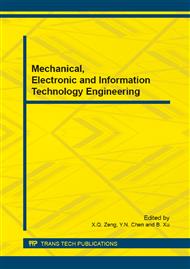[1]
Blake RW, Fish locomotion, Cambridge: Cambridge University Press, (1983).
Google Scholar
[2]
Sfakiotakis M, Lane DM, Davies JBC, Review of Fish Swimming Modes for Aquatic Locomotion, IEEE Journal of Oceanic Engineering. 1999, 24(2): 237-252.
DOI: 10.1109/48.757275
Google Scholar
[3]
Webb PW, Maneuverability—General Issues, IEEE Journal of Oceanic Engineering, 2004, 29(3): 547-555.
DOI: 10.1109/joe.2004.833220
Google Scholar
[4]
Mohsen Siahmansouri, Ahmad Ghanbari and Mir Masoud Seyyed Fakhrabadi, Design, Implementation and Control of a Fish Robot with Undulating Fins, International Journal Of Advanced Robotic Systems, 2011, 8(5): 61-69.
DOI: 10.5772/50898
Google Scholar
[5]
Yonghua Zhang, Laibing Jia, Shiwu Zhang, etc, Computational Research on Modular Undulating Fin for Biorobotic Underwater Propulsor, Journal of Bionic Engineering, 2007, 4(1): 25-32.
DOI: 10.1016/s1672-6529(07)60009-2
Google Scholar
[6]
Wang G, Shen L, Hu T, Kinematic Modeling and Dynamic Analysis of the Long-based Undulation Fin of Gymnarchus Niloticus[C], The 9th International Conference on the Simulation of Adaptive Behavior (SAB'06), Roma, Italy, (2006).
DOI: 10.1109/icarcv.2006.345111
Google Scholar
[7]
Bandyopadhyay P. R, Biology-inspired Science and Technology for Autonomous Underwater Vehicles, IEEE Journal of Oceanic Engineering, 2004, 29(3): 542–546.
DOI: 10.1109/joe.2004.833099
Google Scholar
[8]
H. J. Xu, C. Y. Pan, H. B. Xie, Design and Simulation of the Undulate Machine Imitating the Motion of the Long Flexible Fin, Machinery Manufacturing, 2005, 43(493): 21-23.
Google Scholar
[9]
Low K H, Willy A, Development and initial investigation of ntu robotic fish with modular flexible fins, 2005 IEEE International Conference on Mechatronics & Automation, Niagara Falls, Canada, 2005, 958-963.
DOI: 10.1109/icma.2005.1626681
Google Scholar
[10]
H. B. Xie, D .B. Zhang, L. C. Shen, Undulation Control on the Bionic Device of Long Flexible Fin, Journal of National University of Defense Technology. 2006, 28(3): 99-103.
Google Scholar
[11]
Toda, Y., Fukui, K., Sugiguchi, T, Fundamental Study on Propulsion of a Fish-like Body with Two Undulating Side, Proc. of Asia Pacific Workshop on Marine Hydronamics, Kobe, Japan, 2002: 227-232.
Google Scholar
[12]
Z. L. Wang, Y. W. Wang, J. Li and G. R. Hang, A micro biomimetic manta ray robot fish actuated by SMA, Proceedings of the 2009 IEEE International Conference on Robotics and Bionimetics, Guilin, China, December 19-23, 2009, 1809-1813.
DOI: 10.1109/robio.2009.5420423
Google Scholar
[13]
Y. H. Zhang, L. B. Jia, J. H. He, etc, A Numerical Analysis of an Undulatory Mechanical Fin Driven by Shape Memory Alloy, Proceedings of the 2006 IEEE International Conference on Robotics and Biomimetics, Kunming, China, December 17-20, 2006, 73-78.
DOI: 10.1109/robio.2006.340299
Google Scholar
[14]
M. Sfakiotakis, D. M. Lane, B. C. Davies, An experimental undulating-fin device using the Parallel Bellows Actuator, 2001 IEEE International Conference on Robotics & Automation. Seoul, Korea. May 21-26, 2001: 2356-2362.
DOI: 10.1109/robot.2001.932974
Google Scholar
[15]
H. J. XU, C. Y. Pan, D. B. Zhang, H. B. Xie, Design and Kinematic Analysis of a Bionic Thruster Driven by a Hydraulic System, Machanical Science and Technology for Aerospace Engineering, 2010. 9, 29(9): 1243.
Google Scholar
[16]
H. J. XU. Experimental Research on the Bionic Thruster of undulate fin Driven by a Hydraulic System. IEEE International Conference on Robotics and Biomimetics (ROBIO2009). 2009. 12. Guilin.
DOI: 10.1109/robio.2009.5420687
Google Scholar
[7]
F. Li, T. J. Hu, G. M. Wang, L. C. Shen, Locomotion of Gymnarchus Niloticus: Experiment and Kinematics, Journal of Bionics Engineering, 2005. 2(3): 115-121.
DOI: 10.1007/bf03399488
Google Scholar
[18]
G. M. Wang, T. J. Hu, L. C. Shen and H. M. Shen, Kinematics Analysis of Undulatory Dorsal Fin Propulsion of G. Niloticus, China Mechanical Engineering, 2007. 7, 18(13): 1526-1530.
Google Scholar
[19]
H. Zhou, T. J. Hu, G. M. Wang etc, Bio-inspired Flow Adatability Control Supported by CFD, 2013 The 32nd Chinese Control Conference. Xi'an. 2013. 7: 5854-5859.
Google Scholar
[20]
Han Zhou, T. J. Hu, G. M. Wang etc, Simulation Platform for Fishlike Swimming, Applied Mechanics and Materials. 2013. 11, 461: 451-458.
DOI: 10.4028/www.scientific.net/amm.461.451
Google Scholar



